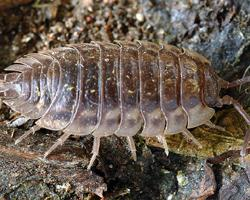
Poids et mesures
| Longueur | 16 mm |
|---|
Statut de conservation
| Intrépide |
Description de l'animal
The Common Woodlouse, scientifically known as Oniscus asellus, is a terrestrial crustacean belonging to the family Oniscidae. This intriguing creature is a familiar sight in many temperate regions, particularly thriving in moist and dark environments such as under stones, logs, leaf litter, and in decaying wood where it plays a crucial role in the ecosystem by breaking down dead organic material.Physically, the Common Woodlouse presents a distinctive, segmented body that can reach up to 16mm in length when fully grown, making it one of the larger species within its genus. Its body is typically a greyish or slate color, sometimes with mottled patterns, which serves as excellent camouflage against the damp, earthy tones of its natural habitat. The body is convex and oval-shaped, with a smooth exoskeleton that provides protection against predators and environmental hazards. This exoskeleton is periodically shed and renewed through a process known as molting, which is essential for growth.
One of the most fascinating aspects of the Common Woodlouse is its ability to roll into a tight ball when threatened, a defensive mechanism known as conglobation. This behavior not only protects its softer underparts from predation but also helps to conserve moisture, which is vital for its survival.
The woodlouse has seven pairs of legs, indicative of its crustacean lineage, which allow for efficient movement across various surfaces. Its antennae, though shorter than those of some other crustaceans, are sensitive and play a crucial role in navigation and sensing its environment.
Adapted to a life of scavenging, the Common Woodlouse feeds primarily on decaying plant matter, but it can also consume fungi and, on occasion, dead animals. This diet makes it an important decomposer in the ecosystem, recycling nutrients back into the soil and promoting healthy plant growth.
Reproduction in Oniscus asellus involves direct mating, after which the female carries the fertilized eggs in a brood pouch located underneath her body. This pouch provides the eggs with protection and moisture until they hatch into miniature versions of the adults. The care provided by the female extends the chances of survival for the offspring in the early stages of their development.
Despite its modest appearance, the Common Woodlouse is subject to a variety of threats, including predation by birds, amphibians, and spiders. Additionally, its reliance on moist environments makes it vulnerable to habitat loss due to human activities such as urban development and pollution.
In summary, the Common Woodlouse, Oniscus asellus, is a fascinating and ecologically important species. Its presence in an ecosystem is indicative of a healthy, functioning environment. By contributing to the decomposition process, this humble creature plays a significant role in nutrient cycling, ultimately supporting a wide array of plant and animal life.
Nouvelles photos d'animaux
Top 10 des animaux
- Dolphin gull (Leucophaeus scoresbii)
- Japanese macaque (Macaca fuscata)
- Greek tortoise (Testudo graeca)
- Stone loach (Barbatula barbatula)
- Russian tortoise (Testudo horsfieldii)
- Galápagos tortoise (Geochelone nigra complex)
- Diana monkey (Cercopithecus diana)
- Moustached guenon (Cercopithecus cephus)
- Common flying dragon (Draco volans)
- Galápagos penguin (Spheniscus mendiculus)